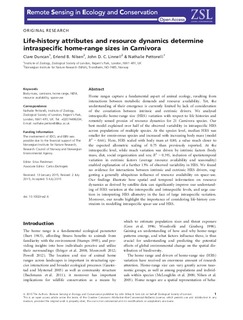| dc.description.abstract | Home ranges capture a fundamental aspect of animal ecology, resulting from
interactions between metabolic demands and resource availability. Yet, the
understanding of their emergence is currently limited by lack of consideration
of the covariation between intrinsic and extrinsic drivers. We analysed
intraspecific home-range size (HRS) variation with respect to life histories and
remotely sensed proxies of resource dynamics for 21 Carnivora species. Our
best model explained over half of the observed variability in intraspecific HRS
across populations of multiple species. At the species level, median HRS was
smaller for omnivorous species and increased with increasing body mass (model
R2 = 0.66). Here, HRS scaled with body mass at 0.80, a value much closer to
the expected allometric scaling of 0.75 than previously reported. At the
intraspecific level, while much variation was driven by intrinsic factors (body
mass, diet, social organization and sex; R2 = 0.39), inclusion of spatiotemporal
variation in extrinsic factors (average resource availability and seasonality)
enabled explanation of a further 13% of observed variability in HRS. We found
no evidence for interactions between intrinsic and extrinsic HRS drivers, suggesting
a generally ubiquitous influence of resource availability on space-use.
Our findings illustrate how spatial and temporal information on resource
dynamics as derived by satellite data can significantly improve our understanding
of HRS variation at the interspecific and intraspecific levels, and urge caution
in interpreting HRS allometry in the face of large intraspecific variation.
Moreover, our results highlight the importance of considering life-history constraints
in modelling intraspecific space-use and HRS.
Body mass, carnivore, home range, NDVI,
resource availability, space-use | nb_NO |

